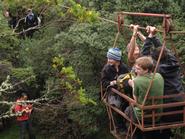
This is part II of the story of the Hamilton Outing Club's adventure in Ecuador over winter break. The group hikes across the paramo (high altitude Andean grasslands) and visits Piñan, a secluded village.
Ivan informed us that the normal order of the trek would be reversed, so that we wouldn’t begin the hike that day and instead would visit a coffee farm. We drove for hours along the curves and bends of muddy, rutted mountain roads that looked out over lush valleys where villages clustered along rivers. From time to time Ivan would have us all stop and get out to look at the scenery.
Eventually we arrived at the headquarters of the Intag Coffee Grower’s Association, where we learned about fair trade coffee and the process behind its production. After sampling the coffee, we went to visit one of the more than 100 farms that make up the association. There, we saw some coffee plants and got to taste many fruits we’d never even heard of before, such as guaba fruit, which grows in long, warped green pods.
The next morning, we took the first of many rides in the back of a pick-up truck to the starting point of our trek, which would take us through the cloud forest and across the paramo (high altitude Andean grasslands between the forest line and the permanent snow line). It was already raining when we began, and it didn’t let up. We spent the entire day crossing waist-deep streams and slogging uphill through knee-deep mud. Ivan mocked us all day because we hadn’t had the foresight to wear rubber boots and ponchos like he did. I think we were all thrilled to finally emerge from the cloud forest and onto the paramo.
It was another few hours before we saw Cuichocha Lake, our destination, shining ahead of us. There, the arreros, or “cowboys,” as Ivan called them, who carried our worldly possessions on horseback, were already nearly done setting up camp. By this time we were all shivering and could barely bring ourselves to change into dry clothing. A delicious multi-course dinner (eaten sitting at stools around a table) and some coca tea helped to warm us up.
However, we still had to pull on our sopping, freezing clothing and hiking boots the next morning and hike to Piñan, a secluded village of thatch-roofed mud huts. Ivan told us that archaeological evidence suggests that the people of Piñan are the descendants of indigenous people who have lived there for several centuries, and he is trying to use this evidence to win the village legal rights to the land.
The village, which just got electricity about two years ago, recently constructed a lodge to encourage ecotourism. We stayed in this lodge (crossing a very treacherous makeshift bridge to reach it) for one night and ate dinner with the entire village in the schoolhouse. It was a really incredible experience to meet the people of the village, but, unsurprisingly, it raised some doubts in our minds about this type of tourism. We were afraid that, to the people of Piñan, we were just another group coming through to gawk at them. Also, because this was a routine encounter for them that had lost its novelty, we wondered whether it had diminished in its genuineness and value as a meeting between two cultures. Nonetheless, we were all grateful for the chance to witness their lifestyle and share a meal with them.
The next morning, we set out for another day of hiking across the paramo. Once again, it rained, and we reached camp soaking wet and violently shivering. But it was all worth it: that evening, the skies opened up and gave us an absolutely stunning view of the Andean mountains rising out of the clouds for miles around us. We could even see the snowy cap of Cayambe, one of the volcanoes we were later to climb, in startling clarity. It was hard to believe that we would be on top of it in just a few days when we could barely convince ourselves that it looked real. Ivan said that he only had such a view on one in 20 trips.
This extraordinary panorama continued the next morning as we packed up and began our final day of the hike. After summitting a final rocky peak with many a sing-along, we spent the rest of the day hiking down from the paramo across wide, grassy hills. As we drew near to the end of our trek, we began to take many breaks – we had been hiking in wet boots for so long that trench foot, salt rashes, and blisters abounded and needed to be taken care of.
Finally we reached the end of the trail and were picked up by a bus that drove us back to Otavalo (with a stop at some thermal springs, first). We said goodbye to Ivan and reunited with Edgar, who took us on an easy day hike around a lake formed in the crater of volcano the next day.
Related:
Posted February 1, 2011
